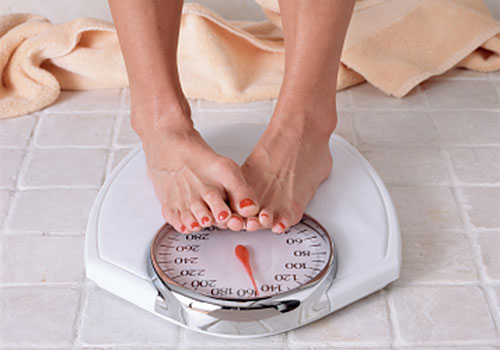 Low-fat, no-fat, healthy fat, too much fat, trans fat-free? “What do you mean?” as my fellow Canadian, Justin Bieber, would say. I conclude my four part series on special diet with low fat cooking or ways to limit the fat intake.
Low-fat, no-fat, healthy fat, too much fat, trans fat-free? “What do you mean?” as my fellow Canadian, Justin Bieber, would say. I conclude my four part series on special diet with low fat cooking or ways to limit the fat intake.
To start, let’s play the word association game. When you hear the word obesity, what’s the first thing that comes to your mind? For me, it’s America. That’s fair, right? I mean the First Lady of the United States consistently goes on The Tonight Show to dance with Jimmy Fallon only to inspire Americans to get moving. As our attention has been on our neighbours down south, obesity is also rising in Canada. Fortunately, our numbers aren’t as shocking. That being said, it’s never too late to start a diet that uses less fat or the healthy ones.
Note: It is important to consult your doctor or a healthcare professional before making any major change in your diet.
The marketplace has so many fatty labels—non-fat, low fat, fat free, high-fat, Balkan fat. Ok, I made up the last one, but you get what I mean. (Right, Beiber?) Before we fear that fat is bad, let’s discuss why it’s important.
What is Fat?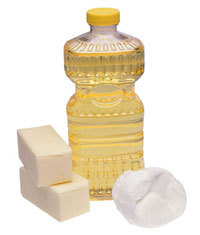
Our bodies need some fat from the foods we eat because it’s a major source of energy. It helps our bodies to process many vitamins and minerals to help us function better and prevent diseases. Let’s not hate on fat. Well, you can hate saturated fats because they are bad for you. Why? They can get stuck on the sides of your arteries, which can lead to high blood pressure and heart disease. Saturated fats are commonly found in butter, processed meats, fried foods, and frozen dinners. Also, start disliking hydrogenated and trans fat. These are manufactured fats that you’d find in most processed food.
Unsaturated fats are a better choice but always in moderation. Avocado, olive oil, fish oils, walnuts, flax seed, etc., are great examples of unsaturated fats.
Tips on Low Fat Cooking
- Remove any visible fat. Who loves the rotisserie chicken from Swiss Chalet? Don’t hate me when I say to remove the skin. I know that’s the best part. You may also hate more when I say remove the pork and steak fat. Sorry, I’m just a messenger.
- Baking and grilling your meats is a million times better than deep-frying. If you’ve been following me on this blog, you’ll know how much I’m a fan of grilling. It tastes better. Trust me.
- Use olive, grapeseed, or sunflower oil for cooking but in small amounts. Measure it. If needed, use water or stock to keep the pan moist. I like putting grapeseed oil in a spray bottle so that it can coat the pan evenly without using too much oil.
- Add flavor. Be playful with your favorite herbs or spices. Or even use mustard for your meats instead of creamier sauces like mayo. Balsamic is always a great flavor for chicken or seafood.
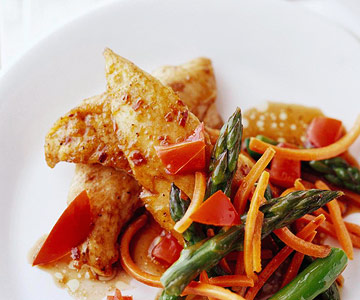
Check out this Balsamic Chicken with Asparagus and Tomatoes recipe from BHG Delish.
Ingredients:
|
Directions
- In a small bowl, stir together salad dressing, balsamic vinegar, honey, and crushed red pepper. Set aside.
- In a large skillet, heat oil over medium-high heat. Add chicken; cook for 5 to 6 minutes or until chicken is tender and no longer pink, turning once. Add half of the dressing mixture to skillet; turn chicken to coat. Transfer chicken to a serving platter; cover and keep warm.
- Add asparagus and carrot to skillet. Cook and stir for 3 to 4 minutes or until asparagus is crisp-tender; transfer to serving platter.
- Stir remaining dressing mixture; add to skillet. Cook and stir for 1 minute, scraping up browned bits from bottom of skillet. Drizzle the dressing mixture over chicken and vegetables. Sprinkle with tomato. Makes 4 servings.
How do you maintain a low-fat diet? We’d love to hear your tips in the comments below.
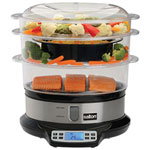 Low fat is easy when you steam your food |
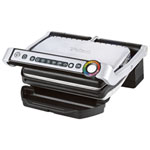
Too cold to get out the BBQ? Try an indoor grill |
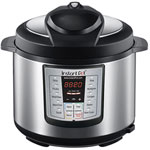 Make healthier meals in a hurry with a pressure cooker |



